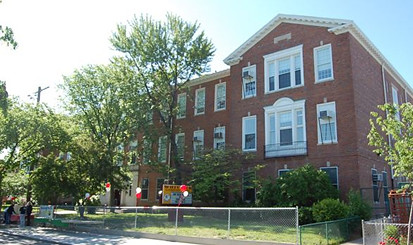The future of center city population retention and quality neighborhood schools
In the long blog entry I wrote a couple weekends ago, "The future of mixed use development/urbanization: Part 1, Housing," I probably buried the lead.
I wrote this:
Note that I do not fully buy into the belief that the housing market will totally and completely change in face of the onslaught of Gen Y.
It is true that a majority of the Gen Y cohort prefer to live in urban (Dupont Circle, Columbia Heights, Georgetown), "urban lite" (Capitol Hill, Friendship Heights, Clarendon, Ballston, Bethesda, Rockville), and maybe Silver Spring is "urban middle," locations when they are younger, while Gen X still was fine with living in the suburbs in their young adult phase and stay in the vicinity as their household changes over time.
But I do wonder as Gen Y ages, if their housing preferences will devolve to the mean somewhat. As they age and their household type changes (from single to married, from married without children to married with children) will they move to less connected, quieter locations, which could be in the city (e.g., moving from Dupont Circle or U Street to Brookland, Shepherd Park, or Takoma) as well as the suburbs. And that is independent of the phenomenon of moving to the suburbs when children are ready for school, because of poorer quality education options in the center city.
E.g., as people get older, they age out of hipper places to live like the Warehouse District in Cleveland and maybe U Street NW in DC, because they get tired of the noise etc. See the past blog entry "Daypart and age-group planning in mixed use (commercial) districts" from 2009, which discusses this.
It might be that Gen Y people will move, but with a greater preference for center city neighborhoods outside of the core, while previous cohorts expressed a stronger preference for suburban locations.
------
A few weeks ago I ran into a planning professional, who was openly derisive when I told him/her where I lived--the person couldn't believe that I wouldn't want to live in an active, amenity rich neighborhood like Dupont Circle, or up and coming places like Columbia Heights or H Street. Well, the fact is, I don't have enough money to live in Dupont Circle or Columbia Heights, and I have burnout with regard to living in a neighborhood like H Street or Trinidad--it takes a lot out of you to work on revitalization in places like that over time.
The fact is, although I don't have children, we can type neighborhoods according to household type and age. Capitol Hill is for older people, while Columbia Heights, Adams Morgan, U Street, etc. are for younger people, especially singles and people in group house situations.
So what happens when people's households change, when they pair up? When they have children? As people age, if they stay in the city, they move to different neighborhoods better situated to satisfy changing needs. E.g., Brookland, where many of the houses have big backyards is great for children. Capitol Hill is pretty quiet at night, unlike U Street, and is better for people who are done with the hustle and bustle, etc.
Planning should have greater focus on how different neighborhoods satisfy different household types, and should work to ensure that the quality of the amenities desired actually meet and satisfy the expectations.

Over the weekend, I went to a neighborhood easter egg hunt for some of the households on or near my block. There were 8 children representing 5 different households. Of course I eavesdropped (and participated in) various conversations concerning what to do as the children get older and the quality of the schools they have access to and attend becomes of paramount concern. (A bunch more households with children didn't participate as it was a somewhat last minute thing.)
Two of the households specifically discussed moving to the suburbs.
As I have been mentioning, I understand why school improvement is a key urban issue, not just in DC, but in cities such as Chicago and New York City as well. Each of the cities now have mayoral control of the school system and mayors in other cities clamor for it. Baltimore also has a school improvement initiative, although it is half local and half state control.
I have advocated a third way on schools. I understand why Mayor Fenty and Michelle Rhee thought it was important to address school improvement. But I thought that their approach was completely and totally misguided and flawed* (* flawed is the other "f" word). Of course the social and community capital available to improving the public schools in DC is further dissipated amongst charter schools and the voucher movement.
(Note that the "enrollment increase" for DC schools this year was all in Pre-K preschool programs, not at schools in the elementary, junior high, and high school levels. Plus, for budget reasons, the school system is cutting back on successful initiatives such as Montessori education, because they don't want to have to pay for accredited Montessori teachers and the higher costs of maintaining the program.)
In my discussions on offices of planning, I make the point that for the most part, most of these agencies are really offices of land use, because they aren't responsible or seen as the lead agency and chief coordinator and director of all of a jurisdiction's planning activities. (This is a bit different in a community like Montgomery County, where the planning agency also does transportation planning, not just land use, as well as parks planning, but I am not sure how much schools planning they do.)
This is definitely the case in Washington, DC.
The schools improvement effort, and especially the maintenance of quality neighborhood schools in each neighborhood, should be seen as the foundation of the most important building blocks in neighborhood stabilization and improvement, resident attraction and retention, community building, etc.
The Office of Planning should be heavily involved in these decisions, and especially the decision to close schools. But I think for the most part, school siting decisions are out of the hands of the planning department.
My immediate neighborhood has three schools. The former Rabaut Junior High School has long been since given over to charter schools, which open and close over the years. It's two blocks away. Whittier Elementary School is about 5 blocks away, and Coolidge High School is about 6 blocks away.

Whittier Elementary School. Photo from the school website.
Coolidge is underperforming. It has fewer than 700 students with capacity for 2,000 or more. Meanwhile the Friends of Bedford Charter School wants to create a charter high school for Ward 4--with limited demand, how could this even be considered?
Whittier, I am not sure about the quality, I do know the enrollment is quite low. But judging by the number of families in the area, if the school captured more than 50% of the neighborhood children, enrollment would be much higher.
If these schools were uniformly excellent, the myriad of young families with children wouldn't be faced with the conundrum of "having to leave the city" as their children enter school, because we would have great neighborhood schools in our neighborhood, and every neighborhood of decent size in the city.
And the problem in my neighborhood is repeated across the city.
Because we can't count on neighborhood schools in DC, and in many other cities, I do not believe that the Gen Y preferences for urban living can necessarily be maintained if urban schools do not improve in lockstep with center city in-migration. Retention of families with choices will not happen if schools don't improve.
On the other hand, maybe all that matters is good pr. People think that Rhee improved the schools when she didn't. Although when it comes down to the level of the individual school, people aren't fooled. They try to get their children into the best schools, through out of boundary lottery procedures, or in charter schools. But even the best charter schools have limited capacity. Then, people think about moving...
Labels: housing choice, neighborhood planning, population/Census, public education/K-12, urban revitalization, urban vs. suburban



0 Comments:
Post a Comment
<< Home